
Create a program that draws a sine wave: y = sin(x)
Expand it to some more complex curves.
or
Create a program that draws triangles, where the vertices are positioned by the user, using the mouse.
def mouseButton(button, state, x, y):
...
glutMouseFunc(mouseButton)
button will have the value GLUT_LEFT_BUTTON, GLUT_MIDDLE_BUTTON, or GLUT_RIGHT_BUTTON
state will have the value GLUT_DOWN or GLUT_UP
Starting point: basic.py
A transformation is a function that converts a set of (X,Y,Z) coordinates into another set of (X,Y,Z) coordinates.
(So far we're working in 2D - (X,Y) coordinates - but OpenGL treats this as 3D coordinates with Z=0)

There are three common types of transformations:
 |  | |
| Translation | Rotation | |
|---|---|---|
 | ||
| Scaling |
A transformation is considered part of OpenGL's state.
Transformations are defined before the geometry that they should affect.
When drawing, vertex data is transformed by the currently active transformation.
glBegin(GL_TRIANGLES) glVertex2f(0.0, 0.0) glVertex2f(0.5, 0.0) glVertex2f(0.25, 0.5) glEnd() |
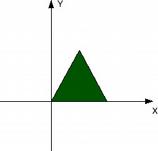 | |
glTranslatef(0.5, -0.2, 0.0) glBegin(GL_TRIANGLES) glVertex2f(0.0, 0.0) glVertex2f(0.5, 0.0) glVertex2f(0.25, 0.5) glEnd() |
 |
Moves subsequent objects by (x, y, z) units.
Note: there is no 2D glTranslate function; for a 2D translation, pass 0 for z.
Rotates objects around the axis (x, y, z), by angle degrees.
In 2D, use 0, 0, 1 as the axis.
OpenGL rotations are right-handed - a positive angle rotates counter-clockwise (in 2D).
Rotations are around the origin, not necessarily the center of an object.
glBegin(GL_TRIANGLES) glVertex2f(0.5, 0.0) glVertex2f(0.8, 0.0) glVertex2f(0.65, 0.5) glEnd() |
 | |
glRotatef(90.0, 0.0, 0.0, 1.0) glBegin(GL_TRIANGLES) glVertex2f(0.5, 0.0) glVertex2f(0.8, 0.0) glVertex2f(0.65, 0.5) glEnd() |
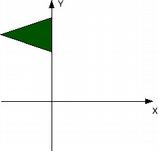 |
Scales objects by the factor x in the X direction, y in the Y direction, and z in the Z direction.
In 2D, pass 1 for z.
A uniform scale - changing the size of an object without distorting it - is done with x = y = z.
As with rotation, scaling is relative to the origin.
glBegin(GL_TRIANGLES) glVertex2f(0.5, 0.0) glVertex2f(0.8, 0.0) glVertex2f(0.65, 0.5) glEnd() |
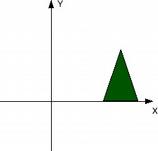 | |
glScalef(0.25, 0.5, 1.0) glBegin(GL_TRIANGLES) glVertex2f(0.5, 0.0) glVertex2f(0.8, 0.0) glVertex2f(0.65, 0.5) glEnd() |
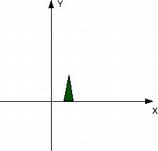 |
Individual transformations can be combined.
Each transformation call accumulates with all the previous transformations.
glColor3f(0, 0, 1) drawTriangle() glTranslatef(0.25, 0.25, 0.0) glColor3f(0, 1, 0) drawTriangle() glTranslatef(-0.25, -1.0, 0.0) glColor3f(1, 0, 0) drawTriangle() |
 |
An identity transformation does nothing - it transforms a point (x,y,z) back into itself.
glLoadIdentity() will clear the current transformation back to identity.
Transformations are not, in general, commutative.
This means that applying the same transformations in different orders can produce different results.
| no transformation | glTranslatef(0.5, 0, 0) glRotatef(45, 0, 0, 1) | glRotatef(45, 0, 0, 1) glTranslatef(0.5, 0, 0) |

| 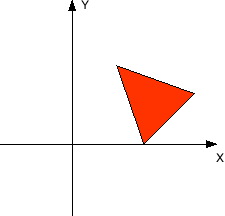
| 
|
Multiple transformations are effectively applied in reverse order.
i.e., the last transformation (the one immediately before the geometry
function calls) is the first one applied to the raw vertex data.
|
glTranslatef(0.5, 0, 0) glRotatef(45, 0, 0, 1) drawTriangle() | 
|

|
An object can be animated by adding transformations over time
i.e. making further calls to glTranslate / glRotate / glScale without
doing glLoadIdentity between frames
This does not work well in general - only for a single object
Best to keep track of a position & orientation (& size) for each object, and apply transformations from scratch on each frame
Example: animXform.py
